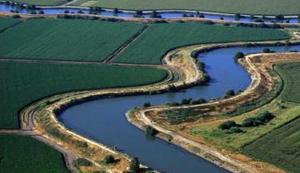The water we drinkExpert urges broad reforms in managing California's water
Most threatening to California’s water situation is the vulnerability of the hub of the state’s fresh water system, the Sacramento-San Joaquin delta, which drains water from the northern Sierra mountains; over the past century, farmers have built a network of more than 1,700 kilometers of levees to protect farmland in the delta from floodwaters; those levees are weak and vulnerable to earthquakes, seasonal floods, and rising waters expected as a result of climate change; the failure of even a fraction of the levees would draw massive amounts of saltwater in from San Francisco Bay, forcing the state to shut off the pumps, cutting off water supplies for many months, and costing the state’s economy billions of dollars

Levees in the Sacramento - SanJoaquin delta // Source: ucdavis.edu
If California hopes to prevent further extinctions of native species of endangered fish, the state should abandon efforts to take desperate measures to save individual species under the Endangered Species Act (ESA) and instead look to bolster entire aquatic ecosystems. This is among a long list of recommendations in a new book which was released last week from the Public Policy Institute of California (PPIC). It was written by a team of scientists, engineers, economists, and legal experts from three University of California (UC) campuses and Stanford University.
“Our assessment of the current water situation [in California] is bleak,” says Ellen Hanak, a PPIC economist, who co-authored the study. “California has essentially run out of cheap, new water sources,” Hanak says. Water quality is deteriorating. Pollution from agricultural runoff and other “non-point” sources is increasing. Efforts to manage water and species recovery are fragmented, with hundreds of local and regional agencies responsible for water supply, water treatment, flood control, and land-use decisions. The upshot is that, despite decades of actions to save aquatic species under the ESA, the trend has been relentlessly downward. Seven of the state’s 129 native fish species are already extinct. Since 1989, the number of native fish species listed as threatened or endangered has more than doubled to thirty-one. Over that same period, the number of species that were “reasonably secure” has dropped from 44 percent in 1989 to 38 percent in 1995 and 22 percent in 2010.
Science reports that even worse crises are looming. Most threatening is the vulnerability of the hub of the state’s fresh water system, the Sacramento-San Joaquin delta, which drains water from the northern Sierra mountains. Massive pumps in the southern end of the delta suck nearly ten billion cubic meters of water per year from the delta and send it to farmers in the Central Valley and urban residents in Southern California. Over the past century, farmers have built a network of more than 1,700 kilometers of levees to protect farmland in the delta from floodwaters. Those levees, most of which are simple earthen berms, are weak and vulnerable to earthquakes, seasonal floods, and rising waters expected as a result of climate change. The failure of even a fraction of the levees would draw massive amounts of saltwater in from San Francisco Bay, forcing the state to shut off the pumps, cutting off water supplies for many months, and
